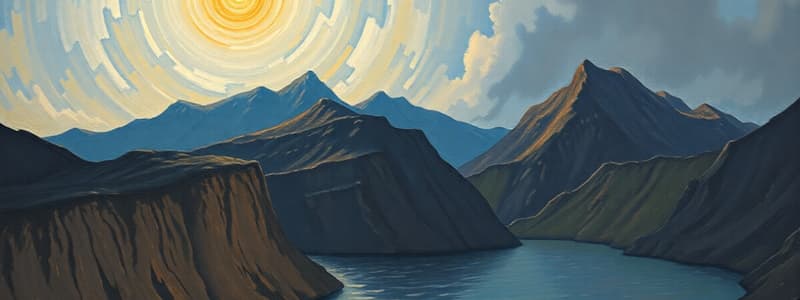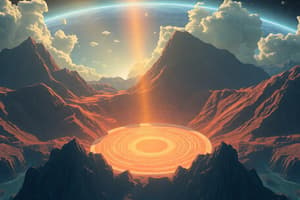Podcast
Questions and Answers
The movement of the ______ causes earthquakes.
The movement of the ______ causes earthquakes.
plates
The gradual wearing away of rock surfaces is called ______.
The gradual wearing away of rock surfaces is called ______.
erosion
A ______ is a large plain created by a river depositing sediments.
A ______ is a large plain created by a river depositing sediments.
flood plain
______ are formed by wind depositing sand in desert areas.
______ are formed by wind depositing sand in desert areas.
A ______ is a curved lake formed by the meandering of a river.
A ______ is a curved lake formed by the meandering of a river.
Flashcards
Why do tectonic plates move?
Why do tectonic plates move?
The movement of tectonic plates is mainly driven by convection currents within the Earth's mantle. Hotter, less dense magma rises, while cooler, denser magma sinks, creating a circular flow that drags the plates along.
What are exogenic and endogenic forces?
What are exogenic and endogenic forces?
Exogenic forces are external processes that shape the Earth's surface, like erosion, weathering, and deposition by wind, water, and ice. Endogenic forces are internal processes driven by heat and pressure within the Earth, such as volcanism and earthquakes.
What is erosion?
What is erosion?
Erosion is the process of wearing away and transporting rock and soil by natural agents like water, wind, and ice. It shapes landscapes and changes the Earth's surface over time.
How are flood plains formed?
How are flood plains formed?
Signup and view all the flashcards
What are sand dunes?
What are sand dunes?
Signup and view all the flashcards
Study Notes
Lithosphere and Plate Movement
- The lithosphere is divided into numerous plates.
- These plates move slowly, a few millimeters annually.
- Molten magma's movement within the Earth causes plate movement.
- This magma movement is circular.
- Plate movement causes changes on Earth's surface.
- Forces causing Earth's surface changes are classified as endogenic or exogenic.
- Endogenic forces act inside the Earth; Exogenic forces act on the surface.
Endogenic Forces
- Sudden movements cause earthquakes and volcanoes.
- Examples of endogenic forces include earthquakes, volcanoes and landslides.
Exogenic Forces
- Gradual movements; examples include erosion and deposition by water, wind, and ice.
- Sea waves, rivers, glaciers, and wind contribute to landform changes.
Earthquakes
- Earthquakes occur when the Earth's crust vibrates.
- The point within the crust where movement starts is the focus.
- The point on the surface above the focus is the epicentre.
- Earthquake waves radiate outward from the epicentre.
- Earthquakes are measured on the Richter scale.
Volcanoes
- Volcanoes are vents or openings where molten rock, gases and ash erupt.
Landforms
- Landforms are shaped by the interactions of various forces.
- Examples include waterfalls, and river valleys.
- Landforms are modified by weathering and erosion.
- River erosion forms meanders, oxbow lakes and floodplains.
Other landforms
- Sea waves and glaciers carve out different landforms.
- Sea waves create sea caves, stacks, and sea arches.
- Glaciers can carve out valleys and leave behind glacial moraines.
- Wind and deposition can also form land features such as sand dunes and loess.
Studying That Suits You
Use AI to generate personalized quizzes and flashcards to suit your learning preferences.




